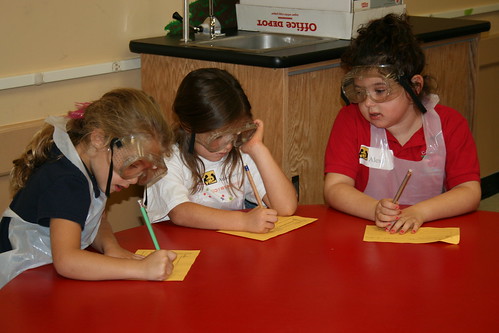
Whether you kid loves science or loves making a mess, kitchen experiments are a great way to have fun and learn the basic prinicples of physics and chemistry. Here’s our top science-based activities for the home laboratory.
Fizzing balloon inflation
What You Need
- A plastic bottle
- A Balloon
- Vinegar
- Baking soda
- Funnel (or a straw)
What to Do
Use a funnel (or failing that, a straw) to pour about two teaspoons of baking soda into an empty balloon. Stretch the opening over the neck of a plastic bottle containing two tablespoons of vinegar, being careful not to let any drop in. When you’re ready, hold the rubber tightly, let the powder drop in and watch as the balloon inflate before your eyes.
The Science
When baking soda (sodium bicarbonate) mixes with vinegar (acetic acid) mix together a chemical reaction occurs, releasing carbon dioxide in the process.
Jumping Raisins
What You Need
- 10+ raisins
- Two big clear glasses
- Clear carbonated drink (e.g. tonic water, Sprite etc.)
- Water
What to Do
Half-fill one glass with water and the other with a clear carbonated drink like tonic water or lemonade. Ask your child whether they think raisins will float or sink when dropped into the liquids. Next, simply take two small handfuls of raisins, five or more in each hand, and drop them into each glass simultaneously. Observe the results. The raisins will initially sink but watch as the ones in the carbonated drink begin rising to the surface and falling again, giving them the appearance of jumping or dancing.
The Science
The raisins initially sank because they have a higher density than the liquids. But their surfaces are covered in dents which become air pockets when they are dropped in, attracting the carbon dioxide bubbles. With the bubbles attached, the raisin is now bigger but has virtually the same mass, meaning it is now less dense than the carbonated drink. This causes it to rise until it reaches the surface, the bubbles pop and the initially density returns.
Bubbling volcano
What You Need
- 850g plain flour
- 300g salt
- Water (warm and cold) 4 tablespoons cooking oil
- Drink bottle (1/2 liter)
- Red food coloring
- 2 tablespoons baking soda
- Vinegar
- Washing up liquid
What to Do
Put the flour, salt and cooking oil in a bowl, adding approximately 500ml of cold water and mixing up with your hands to reach the desired consistency – smooth but not too watery or slippery. Place the empty plastic bottle on a baking tray and mould the mixture around the bottle to form the body of your volcano with the bottle’s opening emerging from the top.
Next, fill the bottle to near the top with warm water and add five drops of washing up liquid that will give your lava more bubbles. Next add your baking soda and a dash of red food coloring. Gently introduce the vinegar and watch as the volcano erupts with bubbling red lava.
The Science
Just as with the balloon experiment, this is all about the carbon dioxide released from the chemical reaction between vinegar and sodium bicarbonate.
Invisible Ink
What You Need
- Lemon/lime
- Paper
- Small paint brush
- A clothes iron
What to Do
Use a lemon squeezer (or just your hand) to extract the juice from the lemon or lime into a bowl. Dip the paintbrush in and begin drawing or writing with the invisible ink on the paper. Leave it do dry and then heat the paper with the iron and see your work appear as if by magic. Be careful not to hold the iron on for too long or you may burn the paper.
The Science
The acidity of the lemon weakens the paper. When exposed to heat, the acid burns and turns brown before the paper.



